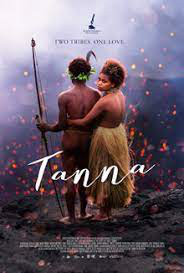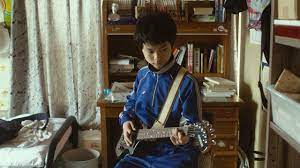
Still image from Tanna
Add these three visually stunning and thoughtful films to your watch list. Each, to varying degrees, tells a story of indigenous culture from an insider’s point of view, and each offers the special pleasure of real people playing themselves in fiction films.
Tanna (2015), 104 minutes; available on Amazon Prime
Vanuatu is a country in the South Pacific, east of Australia and west of Fiji, made up of eighty islands. Tanna, an island in Vanuatu, with an active volcano and warm waters, is home to the Yakel, who are devoted to maintaining their culture, religion, and laws in what they call kastom (loosely, “custom”).
The Yakel had never seen a feature film when Australian filmmakers, Bentley Dean and Martin Butler, first approached them with the idea of making one. Dean and Butler screened Ten Canoes (another wonderful film, involving Australian aboriginal culture) for them as an example. The filmmakers made a great effort to give Yakel control, steeping the film in authenticity. Dean and his family lived on Tanna with the Yakel for seven months before and during production. The script portrays a recent event. All the actors in Tanna are Yakel, and many play themselves. After being the view to screen the final film, they gave their approval. In 2017, Australia submitted Tanna to the Oscars in the Best Foreign Language Film category.

Co-director Bentley Dean films Tanna with Yakel actors
The film opens with someone rhythmically sweeping leaves and singing a song whose lyrics tell the story. The central conflict involves two lovers from neighboring villages who defy the matchmaking protocols and tribal leader authority of kastom. They refuse an arranged marriage.
Tanna has exquisite scenes of tribal life in the jungle forests. Woven into the drama are scenes of people preparing reeds for clothing, sharing child care, and painting faces in preparation for an initiation rite.

Poster for Tanna
An elder walks his young granddaughter, who is a central character, to a mountaintop with a view down to the sea. “Down there is where Captain Cook landed,” he says, “All across the island people have left the old ways. They’ve become lost.” We see a church in the valley and hear the bells. “Our tribes are the last keepers of kastom. We have to hold it tight to survive,” he tells her. One of my favorite scenes involves the chiefs from two tribes in conflict figuring out how to “hold it tight.” Tanna illustrates the effort to balance change with traditional authority and community coherence.
Ainu Mosir (2020), 84 minutes; available on Netflix
In Tanna, the dilemma is how to move forward while maintaining traditional customs. In Ainu Mosir, the dilemma is whether to reach back and revive old traditions.

Poster for Ainu Mosir
The Ainu are an indigenous people who live mainly in northern Japan on the island of Hokkaido. They call their homeland Ainu Mosir. In an interview in Nippon.com, Takeshi Fukunaga, the New York-based filmmaker, who is from Hokkaido, explains his motivation to make this film: “I grew up knowing nothing about them. I felt ashamed of this.”
The film is set in an actual Ainu tourist village. The central character, fourteen-year-old Kanto, lives with his mother, a traditional weaver, who has a shop in the tourist village. His father has recently died. In the opening scene, a woman in handsome traditional garb plays a mukkuri, a jaw harp. In contrast, Kantu dresses in athletic gear and plays Chuck Berry music on his electric guitar. When his mother offers him the opportunity to move away for high school, Kantu shows interest, saying, “This town is not normal. They make you do Ainu stuff.”

Opening scene from Ainu Mosir
The story enlarges when we meet Debo, an Ainu elder and family friend, who offers fatherly guidance to Kanto. Debo wants to revive Iomante, a traditional ceremony involving animal sacrifice, in this case of a bear cub. The idea creates controversy among the elders. Some argue that it will be bad for their reputation and is outmoded, arguing, “You can’t compare us to our ancestors who were hunter-gatherers.” Debo counters, “I identify as Ainu but I can’t seem to grasp what that means. Something is missing.”

Scene from Ainu Mosir
As the conflicts of identity and belonging weave together, Ainu Mosir beautifully illustrates the difficult balance between assimilation and tradition. Fukanaga works to bring authenticity to the story by casting Ainu and telling the story from an Ainu point of view.
Perfumed Nightmare (1977), 93 minutes; available on Kanopy and Amazon Prime
Described as a brilliant semi-autobiographical comedy, Perfumed Nightmare, by Filipino writer, director, and actor Kidlat Tahimik, deserves its praise. The film, told in the first person, moves from the rural village of Balian in the Philippines to France and then Germany, all the while satirizing life under capitalist, neocolonial rule. This personal film includes the filmmaker’s real wife in the scenes in Germany.
Kidlat Tahimik, a pseudonym meaning “silent lightning,” fitting for a filmmaker, was born in the Philippines in 1942, before the country gained its independence from the United States. He studied in Germany, where he befriended Werner Herzog and began his work with film. He was recognized in 2018 as a National Artist of the Philippines.

Poster for Perfumed Nightmare, featuring Kidlat Tahimik
As the film opens, we see a colorful minibus crossing over a small, curved bridge. The narrator says, in English, “This is the bridge to our village.” Then the bus goes into reverse, and we hear “It is the only way out.”
Bridges, literal and cultural, feature prominently in this droll satire. We learn that the original bridge was made of bamboo and built by the narrator’s grandfather. Eventually the Americans modernized and widened it so that military convoys could pass through. The colorful minibus, a jeepney, has been transformed, by hand, from an American military jeep. Later in the film we visit the jeepney factory and hear jeepneys are “vehicles of war transformed into vehicles of life.”
Much of the humor comes from juxtaposition. The narrator sleeps in a bamboo hut in the jungle and wakens to Voice of America on his transistor radio. He is enamored with the space program. While we hear Neil Armstrong’s “One small step for man, one giant leap for mankind,” we see a cow in a field.
Shot in 16mm, the color film has the intimate look and feel of home movies, and lovingly depicts life in Balian, including time with a shaman, religious processions, and even a circumcision ceremony. Dreams, memories, fears and fantasies are creatively depicted in a few surreal sequences throughout the film.

Scene from Perfumed Nightmare
One of my favorite aspects of the film is the soundtrack which, in addition to the narration, features traditional music played on traditional instruments, but also mechanical and natural sounds that resonate in the same rhythms. We hear the traditional music in the hand-building of the jeepneys and in the pulsing of the crickets.
Our narrator’s motivation to become an astronaut leads him to Paris and Germany, where he has funny encounters with aspects of modern life, like escalators, but also feels overwhelmed by the large scale of everything. The young Filipino’s idealism about modern technology gets challenged in Europe as his grandfather’s praises about “the quiet strength of bamboo” echo.

Audrey Wells, a former longtime resident of Urbana-Champaign, is a retired educator and freelance writer.
890 total views, 1 views today